Hold up—did you just see an orca trainer mauled to death by a killer whale? That’s the Jessica Radcliffe video tearing through TikTok and Facebook, but here’s the kicker: it’s totally made up. There isn’t a Jessica Radcliffe working at any marine park, according to multiple sources. And yet, the clip has us all—me included—double-checking reality.
Spotting the Hoax
When I first watched it, my pulse spiked. But then something felt off. No legitimate outlet had picked up the story, which is weird—if a trainer really got attacked, it’d be front-page news. The giveaway? AI still can’t nail human anatomy. Look at the fingers—they jitter like broken marionettes whenever the orca rears back. Believe it or not, those little flubs are our best defense against digital trickery.
Most deepfake videos wobble in that uncanny valley—close to real, but not quite. Despite AI’s leaps, authenticity slips away in micro-moments: a blink too slow, a smile too symmetrical. I’ve seen enough badly looped loops to sniff out the nonsense.
Why We Click—And Share
We’re hooked on the morbid. Negative news draws us in faster than sunshine memes ever could. It’s not just me; studies show we zero in on pain, crash scenes, anything that feels dangerous, because—well—we’re wired for survival. In Morbidly Curious, Coltan Scrivner argues we mentally rehearse worst-case scenarios: “If that orca lunges at me, what’s my play?” Our fight-or-flight systems are always on red alert. Social media knows this instinctive jolt is pure gold.
Chest tightens. Eyes widen. We can’t look away—and then, guilt-ridden, we share the link.
Platforms or Profits?
TikTok, Meta—they boast advanced tech that could spot watermarks or odd pixels. Yet, here we are. (Requests for comment went unanswered—surprise, surprise.) Social platforms have wrestled with misinformation for years, tweaking guidelines, shuffling content-moderator decks. Recently, Meta doubled down on protecting teens, but high-engagement horror clips still fly under the radar. The cynic in me wonders: are the worst shock-and-awe videos left up because advertisers eat them up?
Sad, but true: negativity often equals clicks, and clicks equal ad dollars.
Turning the Tide
Okay, so what now? Blaming TikTok only takes us so far. Real change starts with both creators and viewers.
- Produce content that uplifts.
- Report breakthroughs, not breakdowns.
- Highlight everyday heroes and small kindnesses.
- Pause before sharing the next “OMG it’s real?” video.
It’s a small shift, but imagine a feed that amplifies hope instead of horror.
Sometimes I wonder if we’ll ever get there. But, hey, gradual progress beats standing still.
So, next time you see an orca trainer face-off—with or without a Jessica Radcliffe—remember to pause. Distrust your instincts just enough to verify. It’s not cynicism; it’s self-defense in the AI era.
What do you think? Have you spotted any deepfakes lately—or maybe shared one by accident? Drop a comment below and let’s hash it out. And don’t forget to follow us on Facebook, Pinterest or Instagram for more scary stories, plus a few feel-good surprises along the way.
Sources:
- www.forbes.com/sites/johnbbrandon/2025/08/11/the-jessica-radcliffe-orca-attack-video-is-fake-but-why-is-it-even-on-tiktok/
- www.yahoo.com/news/articles/trainer-jessica-radcliffe-killed-orca-155720613.html
- www.ibtimes.co.uk/jessica-radcliffe-orca-attack-video-confirmed-fake-here-are-other-hoax-deaths-which-went-viral-1741185
Articles from MyViralBox’ contributors and guest bloggers.









